Design Goals and Ideation
- Coulter Baker
- Sep 12, 2016
- 6 min read
The original Disco is Dead was a rhythm-based arcade game that was designed over a period of four days. It was simple, designed to emulate the coin guzzling arcade games of the 80-90’s. Within the game, players took control of Mike and Mark, two disco stars who used the power of disco, and manly slapping, to fend off hordes of zombies. We hit our design targets dead center, and the game was very well received by our peers and institution.

Pictured, Left to right: Screenshot of digital prototype gameplay, live play session, live play session of Bonus round. People were very enthusiastic and excited to play our game, and that trend has continued even in current playtests.
Now, some ten months later, our capstone team has decided to take the idea forwards into a full scale design, focusing on expanding the mechanics, narrative and world of the game to make it a more fleshed out experience. I have the role of game design lead, and a core design target that I have identified through discussion with professors and consideration of our design targets is how to take the primary mechanic of the original game: rhythm-based slapping, and expand it out to fill a 20-30 Min experience, with enough variation to keep the gameplay fresh and provide a lot of diversity. The mechanic was well received, and proved to be highly entertaining. However, it was designed for a fast-paced, short arcade experience, and took only four days to develop. At its core, the mechanic is simple, which is a plus, but it can also get quite repetitive. Without further diversification, it is almost inevitable that the core mechanic will become tiresome during extended play sessions.
To this end, I conducted some gameplay prototyping to find new design opportunities. I conducted a test designing more competitive gameplay between two players, featuring enemies that needed combinations of inputs to defeat. These elements were very well received, and players enjoyed the competitive aspect as well as the greater complexity required to defeat their enemies, and how these elements help diversify the experience. In order to develop wider view of the application and diversification of simple mechanics, I have also been looking into other rhythm/reflex based games with simple core mechanics, and how they diversified their experience.
Dance Dance Revolution – Mechanic: Rhythm and Button Combinations
The archetypal example of a rhythm game, DDR showcases a lot of the most obvious mechanics that a rhythm game can use – combination key presses, adjusting tempo, and beats or game-play events that are synchronized with the soundtrack. Though considering these elements, and discussion with other designers, I have been considering their application in Disco is Dead: Slappy Seconds as well. During a recent paper prototyping session, we tested the validity of creating enemies that needed a sequence of particular button presses to be ousted, and players, after playing both this and the digital prototype, felt that the combination was stronger than the simple directional input alone. This was also coupled with competitive elements, another aspect that many rhythm games employ. Players responded positively to this as well, which has pushed development consideration strongly towards a two-player focus for our game, although we also want to retain single player functionality.
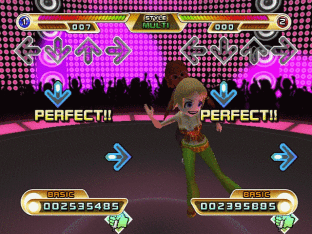
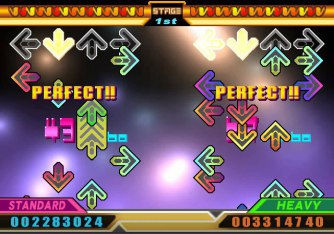
Pictured: DDR Gameplay.
Paper Prototype Examples:

Pictured: The prototype slapping sheet presented to the players, alongside the challenge/combination cards.
To this end, we have been designing a system that will see both players running down two parallel paths, with a different line of enemies approaching each in turn. Score will be kept for both players, and the “Winner” will be announced at the end of each round.
Example Of Gameplay Layout:
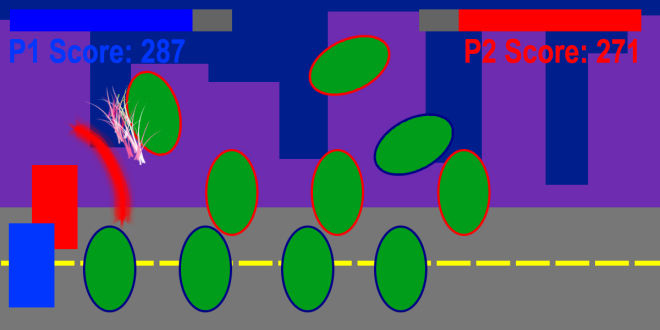
Pictured: Players each defend their own row – enemies are color coded with a glow around them to show who they are directed towards.
GUITAR HERO – MECHANIC: COMBO REWARDS/CHANGE OF TEMPO
One of the more famous rhythm games in modern times, Guitar Hero relies on a fairly simple core experience that is intrinsic to its nature.Mechanically, the interface of the guitar provides the game with intrinsic and unique mechanics – players need to strum while also pressing motes, certain notes are shorter, longer, need to be held, etc.
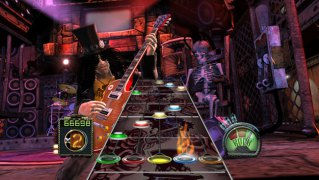
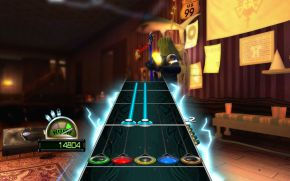
Above: Guitar Hero UI and Gameplay (Top). Example of Star Power (Bottom).
Furthermore, mechanics such as “Star power” allow players to reap the benefits of skill by allowing them to score more points, but strips the colors from the notes, making them more visually obscure. This allows the player to try to score much higher while giving themselves a slight handicap, allowing experienced players challenge themselves for greater rewards. This kind of option could add another layer of depth to Disco is Dead: Slappy Seconds as well, allowing a fundamental change of pace to be instigated by the player after a certain point in time.
Furthermore, considering guitar Hero’s intrinsic control scheme, and how it would apply to Disco is Dead: Slappy Seconds, has lead us to consider the intrinsic mechanics of slapping, we could design a control system that prioritizes the physical nature of the player’s contact with the game’s buttons, based on such elements as the length of time a button is pressed, how quickly it was pressed, slapping intervals, etc. To this end, our team will be starting development with Rock Band drums as a control scheme in addition to controllers and keyboard, and will be looking into developing a custom control method using Makey Makey.
ELITE BEAT AGENTS – MECHANIC: COMBINATION AND PACING OF SMALL CHALLENGES/EXISTING MECHANICS
Elite Beat Agents is different from the other rhythm games presented, not only in overall gameplay and mechanics, but how those mechanics tie into the narrative and presentation of the game. Whenever the player hits/misses a note in EBA, there is a measurable reaction on the top screen – the characters being shown jump/trip, catch a ball/drop it, etc. the game visually represents the player’s mechanical actions and translates them to a narrative action. This ties in to how we want slapping to work as a mechanic, allowing players to influence characters through slapping as well as enemies, and intertwining narrative and rhythm-based gameplay together.
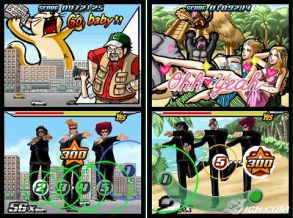
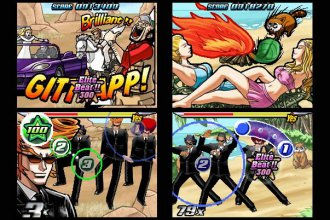
Above: Different types on interplay – sliding, tapping, etc. The circles indicate the time before the beat should be tapped, and numbers guide the order in which they should be tapped, giving further clarity.
Elite beat agents core gameplay consists of tapping areas of the screen as they become active – missing them will cost the player “Health” and make them lose their combo. It’s interesting to note that this simple mechanic is diverse enough to hold the overall experience, as the time given for any tap, along with the number that appear in a row, and the specific interplay that is needed to complete them – sliding, spinning, etc. these are design considerations that I intend to take forwards, regarding how to modify the mechanics and add diversity through the timing itself, and how the mechanics are visually diverse, rather than creating a huge scope of mechanics that overburdens the team and development of the project.
One example of how this could be implemented might be in the act of the kind of slaps required. there could be an enemy that would require a slap button to be held, in order to build up enough force to kill it, or an enemy that jumps from one player’s lane to the other when it is struck, etc. some enemies could approach quicker, or not reveal what inputs are needed to kill them until they are almost upon the player, etc. the player could see one slow moving enemy approaching, only to have three faster ones rush ahead of it, suddenly changing the required presses from what they were expecting. These kind of micro-mechanics can greatly diversify challenge and gameplay without requiring an actual change to the core mechanics that already exist.
Progress Plan:
Moving forwards, there are a variety of options that our team can take to try to develop and expand upon our core mechanic. For the time being, we will continue testing and begin digitally prototyping of the dual path competitive system to see how it works for players, and the kind of response we get through play-testing, and the multi-button inputs that are required to defeat enemies. For the time being, it is most important that we develop the two initial systems that integrate most cleanly into the game flow that exists, and will serve as a good starting point to branch out from. In the near future, we will be prototyping an testing a “combo” system that will build up a “funk” meter over time, which will allow players to activate a mode similar to star power, allowing them to more effectively score points and cut their enemies down. We have also already ordered a Makey Makey system, so that we can begin consideration of how to develop our own controller that will best support the game experience and provide the most enticing presentation at the job fairs/events we are aiming to take it t, such as Level Up, Etc. Finally, once we have some of the core mechanics in play – button inputs relating to enemies, variable enemy speeds, etc. I will be looking into how to combine and arrange them in order to create varied challenges and different threats, without actually requiring that more mechanics be added.
Picture Credits:
Dance Dance Revolution:
https://en.wikipedia.org/wiki/Dance_Dance_Revolution_Hottest_Party_2
http://dancedancerevolutionddr.wikia.com/wiki/Vivid
Guitar Hero:
http://wiinkel.co.za/index.php/games/wii/item/guitar-hero-iii-legends-of-rock
http://www.mobygames.com/game/windows/guitar-hero-world-tour/screenshots/gameShotId,378071/
Elite Beat Agents:
https://binarymessiah.wordpress.com/2012/02/25/elite-beat-agents-710/
http://ca.ign.com/articles/2007/02/26/elite-beat-agents-down-under
























Comments